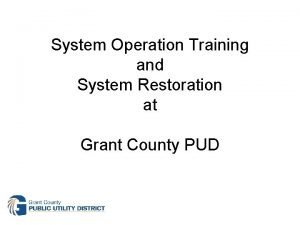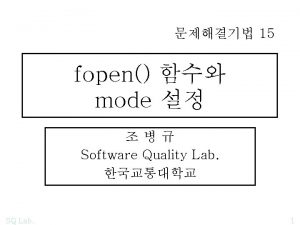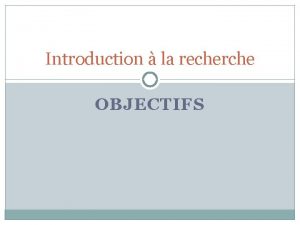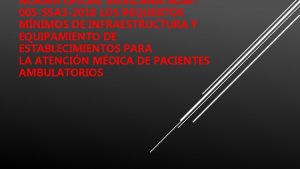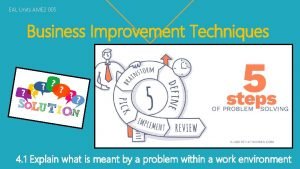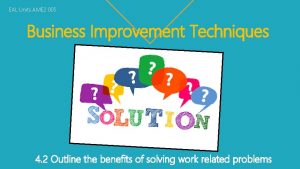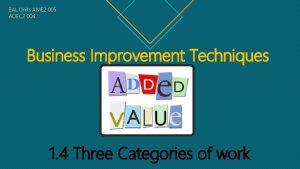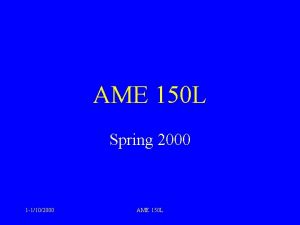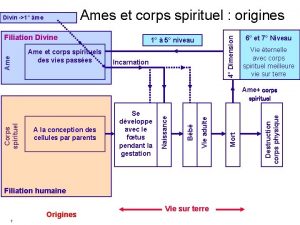EAL Units AME 2 005 Understand what is


















- Slides: 18

EAL Units AME 2 005 Understand what is meant by continuous improvement Business Improvement Techniques 1. 5 Different categories of waste

Aims & objectives 1. 4 • Understand what is meant by continuous improvement • 1. 5 Using guided research and work activities to define the 8 different categories of waste

Research • Using Moodle. • AME 2 Machining pathway • Unit AME 2 004 • Week 5 Continuous improvements Benefits • Download and save the document into a folder you have made. • Folder name- AME 2 004 Business improvement • Document name: 1. 5 Define categories of waste

Re cap. What are the 3 categories of work? • Elaborate on the 3 categories of work • What is a good process layout

What do you think the main categories of waste are? q. Transport q. Inventory q. Motion q. Waiting q. Over production q. Over processing q. Defects q. Skills/Unrecognised people potential. wastes


8 Categories of Waste (1) q Transport: q Not all transportation is waste. q However, the unnecessary movement of people, products, parts, or other items adds expense and risk to processes without adding value. q Examples of the waste of transportation include: q Sending unsold products from the store back to the warehouse q Ordering parts or products from distant suppliers when closer options are available

8 Categories of Waste (2) q Inventory q The wastes of inventory and overproduction go hand in hand. q If a product is over produced, it has to be stored somewhere, tying up space and requiring additional tracking and management. q Depending on where the inventory is stored, it can also lead to wasted transportation and motion. q Besides the obvious idea of unsold products sitting in a warehouse, the waste of inventory can be found in lots of places: q. Shelves of unused office supplies / Too much bedside equipment in a hospital / Stacks of promotional literature or pre-printed forms / Perishable items that will go bad before they are used or sold / Applications on your desktop that you never use

8 Categories of Waste (3) q Motion is similar to transportation, but it involves unnecessary activities within the workspace. q Moving parts around work places in an unorganised way. One of the aspects we looked at. q Software that requires 10 clicks to get to the screen you want q Workers searching for missing tools or office supplies q Printers and other equipment that are not conveniently located q Inadequately stocked examination rooms

8 Categories of Waste (4) q Waiting q The waste of waiting takes two common forms. q People and process often must wait because the next step in the process isn’t ready for them yet (waiting for parts that are being machined. That then need milling), waiting because they don’t have the inputs necessary to act. q Engineers waiting for code to be developed q Emergency room patients waiting for test results q Landscapers waiting for soil to be delivered q Airplanes waiting for a gate to open up

8 Categories of Waste (5) q Over Production q These days, just about everyone is familiar with just-in-time manufacturing. q Businesses are careful not to create products before there is demand, with good reason. q Overproduction unnecessarily ties up resources and increases the likelihood of inventory and transportation waste. q Huge meals in restaurants q Hospitals with more beds than the community needs q Commuter trains with more cars than necessary q Overstaffed retail stores q Too many meetings, or the wrong people in meetings q Parts taking up ware house space

15 Min, Short Activity • Create a word document, outlining the key elements of just in time manufacture. • Save it in you unit 004 business folder, as just in time manufacture • DO NOT COPY AND PASTE • Evidence on the document the websites you used by adding the hyperlink/s

JIT Just-in-Time manufacturing • Is an organisational Improvement Technique • Just-in-time is a lean manufacturing philosophy that means producing the necessary items in necessary quantities at the necessary time. • E. g. Manufacturing to order, not to stock. • It is a philosophy of continuous improvement in which non-value-adding activities (or wastes) are identified and removed. • Just-in-time (JIT) manufacturing is frequently described as a process for achieving continuous improvement through the systematic elimination of waste and variations.

8 Categories of Waste (6) q Over processing q When Lean specialists talk about over-processing, they mean adding more complexity to a product, task, or process than is necessary to get the desired value. q Over-processing is not just a problem in manufacturing. It happens in every sector. Here’s what it looks like: q Software features that no one ever uses q An MRI when an X-ray would suffice q Complex purchasing processes with multiple approval levels q What might be an example of over processing in your work? q Over tolerancing

q Defects 8 Categories of Waste (7) q We will use a restaurant as an example (How? ? ) q I ordered a Mc. Donalds cheese burger. q I specifically asked for no gherkins. (I hate gherkins). q Alas, this was to much information for the highly skilled operative to retain for the full 15 sec. q So my cheese burger arrived fully gherkined up. q When I pointed out the error, the burger was lobed in the bin. q And the burger cooking operative ordered to work on a new one. q Wasted time, and materials q This is a perfect example of how mistakes cause waste. Here a few more: q. Misdiagnoses in healthcare that lead to unnecessary tests or treatment q. Products that are shipped to the wrong address q. Manufactured items that don’t meet the customer’s specifications q. Information that isn't communicated effectively or well understood

8 Categories of Waste (8) q Skills / Unrecognised people potential? q Perhaps most damaging of all is the waste of human potential. q Wasted human potential can lead to employee turnover, increased absenteeism, and disengagement. q It happens when: q Employees do not have the opportunity to learn new skills or utilise hidden ones q Employees are not involved in process improvement q Workers are not given the chance to advance within the company

Conclusion • Here’s the good news about waste. • Every time you identify waste within your organisation, you have found an opportunity for improvement. • Reducing any of the 8 wastes of Lean can have a significant impact on business results.

Thank You
 To understand recursion you must understand recursion
To understand recursion you must understand recursion Csc-005
Csc-005 Sol 003
Sol 003 Per 005 1
Per 005 1 Hoklas 005
Hoklas 005 D.s. n° 005-2012-tr
D.s. n° 005-2012-tr Nrg gu 005
Nrg gu 005 Afnor z44-005
Afnor z44-005 100000x0.1
100000x0.1 Nom-005-ssa3-2018
Nom-005-ssa3-2018 Cmbg staffing
Cmbg staffing Bd microfine
Bd microfine When units manufactured exceed units sold:
When units manufactured exceed units sold: Fronter eal
Fronter eal Eal victorian curriculum
Eal victorian curriculum Eal proficiency assessment
Eal proficiency assessment Eal nexus
Eal nexus Ofsted eal
Ofsted eal Windows eal
Windows eal



